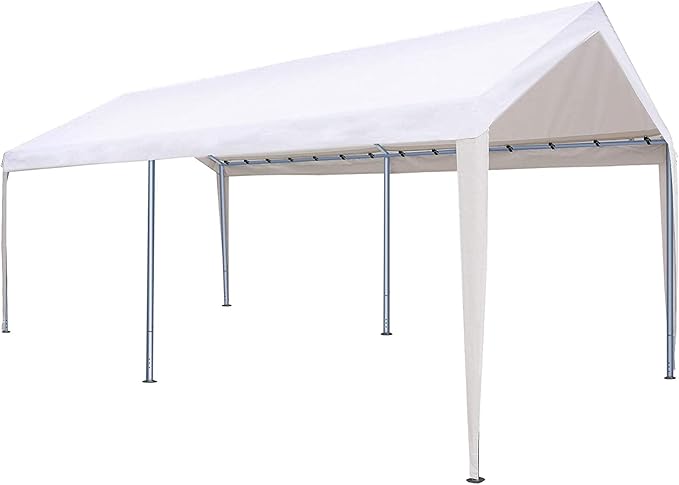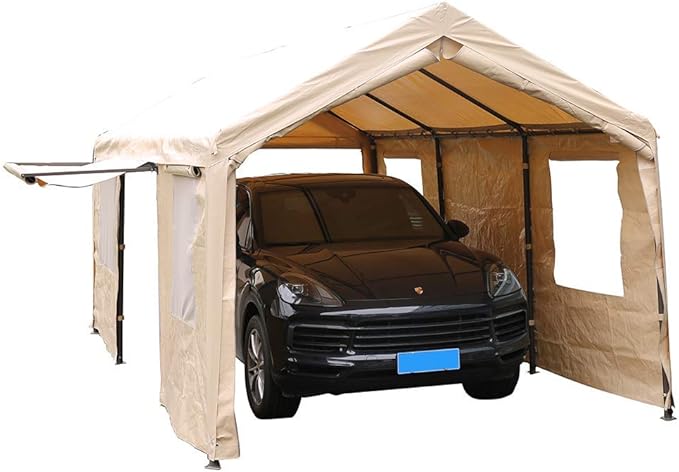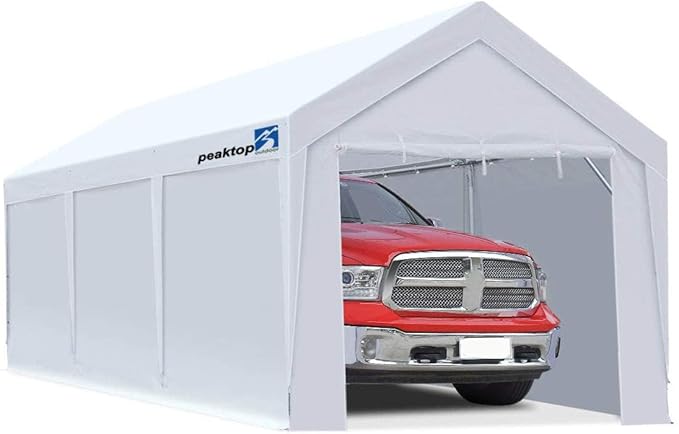You don’t have to leave your car outside exposed to the elements. A carport is a perfect solution when you don’t have a garage, or your garage is full. All you need is some flat, level ground, and you can have a protected place for parking your vehicle. A cover can protect your vehicle from the sun’s harsh UV rays, preserving your vehicle’s paint and helping your vehicle to look newer for longer. In addition, it can give you cover when it’s raining, making it easier to get in and out without making a mess of your interior. Our guide to the best carport kits will help you find the perfect setup for protecting your car.
Best Carport Kits Reviews & Recommendations
Advance Outdoor Heavy Duty Carport

Get the perfect amount of coverage with this adjustable carport. The 10 ft W x 20 ft L carport has an adjustable height between 9.5 and 11 feet and removable sidewalls. Choose from beige or white for the color of the heat-sealed triple-layer 180-gram polyethylene cover. The frame is heavy-duty 1.5-inch diameter galvanized steel with either solid leg poles, 16 steel pegs, and eight auger anchors. You can remove the sidewalls entirely and roll the doors up and out of the way. To make the frame stronger than others, the steel is thick at 1.2 millimeters.
While the frame and cover are durable, the hardware pieces aren’t the best. The bolts can easily strip, and the Velcro straps that hold the doors aren’t strong enough for long-term use.
PROS
- Heat-sealed, triple-layer 180-gram polyethylene fabric
- Two removable sidewalls
- Two removable doors with zippers
CONS
- Bolts easily strip
- Weak Velcro strap for holding the door
- Inconsistent construction
Abba Patio Portable Lightweight Carport

This affordable carport is lightweight and portable yet looks elegant with an attractive design. Choose from ivory or khaki for your 10 ft W x 20 ft L carport. The durable triple-layer polyethylene fabric covers the peaked frame and four legs is UV-, tear-, and water-resistant. The lightweight frame poles measure 1.5 inches in diameter and are powder coated to prevent chipping, peeling, and corrosion.
The lightweight design of the frame does make it more susceptible to bending, so be careful with heavy weight on top of it or high wind. The fabric can quickly develop holes, which causes the carport to leak. It also doesn’t come with sidewalls or end doors, leaving your vehicle more exposed than other carports on this list.
PROS
- Fully collapsible
- Powder-coated steel framework
- Tear-proof, anti-UV, and waterproof, durable polyethylene
CONS
- Metal poles easily bend
- Fabric can have holes
Quictent Heavy Duty Galvanized Car Shelter

Have confidence that your carport will survive a rainstorm with the steel cables and ground supports. Choose from two sizes 10 ft W x 20 ft L or 13 ft W x 20 ft L. A galvanized steel frame supports the extra thick polyethylene fabric. Four extra high-strength steel cables and six ground bars stabilize your carport to prevent twisting, swaying, and other movements. The extra-thick industrial grade polyethylene is UV, water, and tear-resistant.
Despite all of the reinforcement, if you want your carport to last, you need to take the cover off when there is heavy snow and high wind. The design of the cover makes it more susceptible to getting caught in the wind, putting undue stress on the cover fabric and frame. It’s also tough to roll up the doors because it is one solid piece for the entire end, making them heavy and awkward for one person to handle.
PROS
- Reinforcement ground bars
- Extra thick fabric
- Wood bracket reinforcement
CONS
- Not suited for use in heavy snow
- Hard to roll up the doors
- Easily catches the wind
Sorara Carport Heavy Duty Canopy Garage

Have more than a carport with the premium design of this 10 ft W x 20 ft L carport. Each of the sidewalls features two large windows. A lift-up doorway between the windows provides a canopy cover and easy access from the side of the carport. Line this side door up with the exterior door to your home, and you have a protected walkway when the weather is bad. Both ends have roll-up doors for plenty of cross ventilation. The frame is a durable two-inch diameter rust-resistant steel frame with supportive corner and base plates. The polyethylene cover is UV and water-resistant with heavy-duty bungees that tightly secure the cover to the frame.
The peaked design of this carport makes it hard and heavy to roll up the end flaps. The window covers are hard to align, leaving gaps where rain can get in. You’ll also be disappointed by the small size of the stakes and their inability to secure this carport to the ground properly.
PROS
- UV, water, and wind resistant
- Removable front and back door
- Windows in sidewalls
CONS
- Hard to roll up doors
- Window covers not aligned
- Small stakes
Peaktop Outdoor Store Upgraded Heavy Duty Carport

This heavy-duty carport is perfect for leaving up throughout the year. It measures 10 ft W x 20 ft L and comes in white or beige. The frame is galvanized steel, measuring 1.5 inches in diameter with thickened connectors that measure 1.65 inches. The galvanized finish helps protect the frame from rust, corrosion, peeling, and chipping. The canopy fabric is extra thick polyethylene, measuring 180 grams and is waterproof, tear-resistant, and anti-UV. A unique feature of this carport is the windproof edge cover with an extended 10-inch flap that protects your vehicle from water getting under the canopy and getting your vehicle wet. A leg cloth and adjustable hook cover each pole.
One drawback of this carport is that the zippers are small, making them less durable and harder to use. The canopy cover also has a loose fit on the frame, allowing it to flap and move in the wind.
PROS
- Triangular reinforcement beams
- Extra-thick 180-gram polyethylene fabric
- Edge of the top cover has an extra ten inches
CONS
- Small zipper
- Loose fit
- Leaks in heavy rain
How We Selected The Products
Our product selections, rankings, and awards for this story are based on research. While we haven’t conducted real-world testing on all of these products yet, we’ve looked at consumer testimonials and data, tutorials, and general discussions on social media and in forums. We also consider price and specification in the context of the segment. And, of course, we rely on our institutional knowledge of the automotive landscape to weed out weak products.
We focused our list on affordable and portable carports that our readers can easily purchase and set up on their own. From there, we narrowed down the options to carports that would be large enough to comfortably fit the majority of vehicles. Finally, we considered the features that would make a carport more durable and potential weak points that could cause a carport to not fulfill its intended purpose.
Buying Guide/What to Look For
The first step when buying a carport is to decide your budget and how permanent you want it to be. This will help direct you towards the correct type of carport you need. Then decide how big you need it to be. Finally, look for one that is easy to assemble and has durability features as well as an attractive design.
What to Consider When Buying Carpool Kits
Types of Carpool Kits
Poly Material
These carports are lightweight and portable. You can set them up on your own, and they typically don’t require a permit. If you decide to take it down or move it in the future, you can do so easily. These carports feature a frame that’s typically made out of aluminum or steel with a fabric canopy covering over it. This affordable solution will provide your vehicle with a basic level of protection. However, they are no match for falling tree branches, snow, and high winds. This lack of durability can lead to your carport not lasting as long as you’d like. With regular maintenance, you can help your carport last longer, such as removing the canopy when you know a storm is coming.
Steel or Aluminum
This type of carport is ideal if you need a heavy-duty solution. However, you’ll pay much more for this type of carport. If you need to protect your vehicle in a densely wooded area or expect heavy weight on the roof, then this is the better option. Once you build your steel or aluminum carport, it is not portable. You are more likely to need a permit or approval to build this type of carport since many places will consider it a building structure. This adds to the cost and makes adding a carport more complicated. Their advantage is that you don’t have to worry about them getting damaged or blowing away in a storm.
Carport Kits Key Features
Durability of the Materials
You’re investing in a cover that’s supposed to provide your vehicle with additional protection, so you want it to last. A durable kit uses high-quality materials for the frame and cover. Aluminum and steel frames are strong and corrosion-resistant. Aluminum is lighter in weight, making it easier to set up and more likely to blow away in strong wind. Steel won’t bend or move as easily but is also noticeably heavier. The fabric for the cover is typically made out of polyethylene. Look for a thicker fabric for greater durability. It should also be water-, wind-, tear-, and UV- resistant. Finally, the more supports the carport has, the more durable the overall construction will be. There should be reinforcement at the stress points and joints.
Ease of Assembly
Choose a carport kit that comes with clear directions and a simple assembly process. This makes it easier and faster to get your carport up and ready for use. If you’re by yourself, consider this because some require two people. Additionally, look for one that’s easy to install and remove the canopy fabric. This will make you more likely to remove the cover when inclement weather comes. The kit you buy should come with everything you need, including stakes to anchor the carport to the ground. Many kits come with stakes, but they are too small to be effective at securing the canopy in the majority of ground and weather conditions.
Design
Some carports look plain and almost industrial in their design. This is unattractive and may not be what you’re looking for when it’s highly visible on your property. Other carports have a more polished design with doors and windows. Pay attention to the roof design, too. A flat roof will collect leaves, snow, and branches. A pitched roof is a better option because the debris is more likely to slide down. Sidewalls and doors are nice because they provide more protection for your car. There are also basic design options, such as size and color. The size of your carport needs to be wide and tall enough to cover your vehicle. Choose a color that you like and looks good on your property.
Carport Kits Tips and Tricks
As with something you do for decades upon decades, you pick up a few tips and tricks along the way in terms of selecting the right product and/or using it. That’s the case with us and carport kits. To help you bridge the information gap, here’s a selection of what we’ve learned along the way.
- If your area is prone to thunderstorms and lightning, don’t put your carport near tall trees. The metal in the carport will attract lightning and could damage your car, the carport, and the tree.
- Check your local building codes before setting up your carport. You may need a permit to erect it, depending on the size and location of your property.
- Use the correct anchoring system for the ground material you are anchoring the carport to. There are different systems for asphalt, grass, and sand.
- Level the ground before setting up your carport. This keeps all of the feet in contact with the ground and reduces stress on the frame.
- Take the fabric covering off of your carport when you know bad weather and high winds are coming. This prevents damage to the carport and vehicle.

Best Carport Kits


